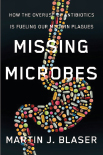BOOKMARK
- Title: Missing Microbes: How the Overuse of Antibiotics Is Fueling Our Modern Plagues
- Author: Martin J. Blaser, MD
- Publisher: Henry Holt and Company
- Publication Date: 1st Edition, April 2014
- Price: $28.00, hardcover, 228 pages
On September 3, 1928, Scottish biologist Alexander Fleming returned to London from a vacation and sorted through some petri dishes containing colonies of Staphylococcus. He noticed something unusual in one dish: It was dotted with colonies except for one area where a patch of mold grew. Immediately around the mold, which was producing what would later be identified as a strain of penicillin, no staphylococci were growing. So begins the story of penicillin, the “wonder drug” that saved countless millions who would otherwise have died of infection.
Flash forward a half century, and because of antibiotic overuse, certain bacteria have become antibiotic resistant, a widespread issue the Centers for Disease Control and Prevention (CDC) calls “one of the world’s most pressing health problems.” However, according to a recent edition of the book Missing Microbes: How the Overuse of Antibiotics Is Fueling Our Modern Plagues, the overuse of these wonder drugs has also contributed to the rise of what the author, Martin J. Blaser, MD, calls our modern plagues: obesity, asthma, allergies, diabetes, and certain forms of cancer.

Author’s Credentials
DR. BLASER’S RESEARCH in this area has also concluded that antibiotic overuse during childhood poses a great risk to long-term health. But he’s not just sounding the alarm on antibiotic overuse, he also speculates that C-sections are extremely deleterious to health by depriving babies of vital contact with their mother’s microbes.
Blaming C-sections, which have saved countless babies and their mothers, for a childhood beset with illnesses might turn off many readers of orthodox science, questioning the author’s qualifications. Yet Dr. Blaser’s scientific credentials are hefty. He is an infectious disease specialist who has studied the role of bacteria in human disease for more than 30 years. He is Director of the Human Microbiome Program at the New York University and has major advisory roles at the National Institutes of Health (NIH). He’s also had more than 100 media appearances, including on National Public Radio, The Today Show, Good Morning America, and many more. And he’s also a skilled writer who has turned out an interesting and proactive book.
‘Disappearing Microbiota’
DR. BLASER BEGINS his microbe journey with an overview of the various maladies, obesity included, that he believes are caused, at least in part, by the overuse of antibiotics and what he calls our “disappearing microbiota.” He writes: “But as terrible as these resistant pathogens are, the loss of diversity within our microbiome is far more pernicious. Its loss changes development itself, affecting our metabolism, immunity, and cognition.”
In fact, much of the postulates in Missing Microbes have been validated by the NIH Human Microbiome project, which has been compared to The Human Genome Project in scope. More than 200 scientists at 80 institutions sequenced the genetic material of bacteria taken from 250 healthy people. The findings were game-changing, including the role of bacteria in the human immune system, and, yes, in the difference between C-section and vaginal birth.
Mother and Child
IN ONE OF THE BOOK’S best chapters, “Mother and Child,” Dr. Blaser gives a riveting account of how microbes in the mother’s intestinal tract store up energy, another population of microbes begin shifting and building in her vagina. He notes that women of reproductive age carry lactobacilli, which make the vaginal wall more acidic and inhibit or kill harmful bacteria.
The loss of diversity within our microbiome… changes development itself, affecting our metabolism, immunity, and cognition.”— Martin J. Blaser, MD
Tweet this quote
When the mother’s water breaks, a rush of bacteria-laden fluid baths her thighs, and as the formally germ-free baby pushes out, it comes in contact with the lactobacilli. “Very flexible, rather like a glove, the vagina covers the newborn’s surface, hugging its soft skin, which is like a sponge…taking up the vaginal microbes rubbing against it.”
The author does a good job toggling back and forth between historical background and the present dilemma we face in our almost postantibiotic era. Moreover, he cites numerous studies and strong anecdotal evidence to back up his claims. To his credit, the narrative flow never gets bogged down by didactic lecturing or dense science; instead, it clips along and at its best sections reads like a novel.
Antibiotic Overuse and Cancer
FOR THE ASCO POST readers, there are several discussions about the relationship between antibiotic overuse and cancer. For instance, he speculates about the relationship between gut microbes and their metabolic capacity, which might have important bearings on estrogen status, something he calls the “estrobolome.” He makes a theoretical connection to the altered estrobolome and BRCA mutations, but he concedes, “The role is just speculative, but we are paying attention to it in the lab.”
Dr. Blaser ends with a chapter on solutions, probably the book’s weakest section. But that’s not his fault. The fact is the overuse of antibiotics is moderating their use, and understanding that playing in the dirt, at an early age, isn’t a bad thing. The hundred trillion or so good bacteria that live on or in the human body are not something to be scrubbed away. The evidence behind Dr. Blaser’s warnings about the overuse of antibiotics and the loss of microbes in our oversanitized world is overwhelming. This book is recommended for The ASCO Post readers. ■

